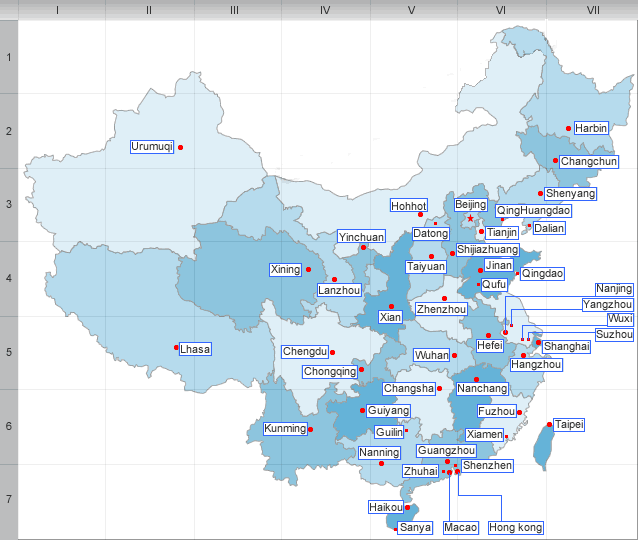Haimen Overview
Haimen is a county-level city under the jurisdiction of Nantong Prefecture City. The name, Haimen, is comprised of two Chinese characters, Hai and Men, meaning “Sea” and “Door or Gate” in Chinese, implying the city's crucial location at the low end of Yangtze River.
As a ancient township, Haimen started its jurisdiction in 958 A.D, after numerous small sand islands merged into a land, which were formed by heavy sediment from sand brought by Yangtze River, estimated at 700 million tonnes a year.
Haimen City is under the jurisdiction of Nantong. The city is comprised of 21 towns and 1 township, one provincial economic development zone, one port, and one special cotton-plantation farm. Haimen has a physical land size of more than a thousand square kilometers and its population is about a million.
Geography, Resources and Climate
On the northern bank of Yangtze River, Haimen City is under the jurisdiction of Nantong, bordering two two neighbor cities: Qidong and Tongzhou, and facing Shanghai in the opposite of the river.
The city, dubbed the "Golden Coastline”, encounters the East China Sea on its northern part but faces the low end of Yangtze River on its southern territory.
Yangtze River divides Jiangsu Plain into two halves, Jiangsu South and Jiangsu North and Haimen is just on its northern bank. This has brought difficulties into traffic communications between the two parts of the province in history, north and south, which leaves the navigation as only way to communicate with south.
The situation has been forever changed after the openings of Sutong (Suzhou-Nantong) Yangtze Bridge in April 2008 and Chonghai (Shanghai's Chongming-Nantong's Haimen) Crossing Yangtze Bridge will also been finished in 2008 to 2009. Haimen’s capacity of traffic communication with the Southern Jiangsu has been tremendously enhanced.
The city has a warm and wet subtropical climate under the influence of the East Asia monsoon. Seasons are distinct and its residents enjoy sufficient sunlight and abundant rainfall.
Economy, Industry and Environment
Haimen City traditionally relied on its agriculture earnings but now the total earning of the sector is only 3% of its industrial income.
Over years, the industrial growth is significant and new industrial sectors, including the service and traveling, construction and high-tech industries, have been tremendously intensifying the city’s economy. Fresh foreign investments continue pouring in and high-tech projects and exports are expanding.
Upon the completion of two crossing-Yangtze River bridges, Haimen, as well as other cities in the northern Jiangsu, is further tightly connected with the South of Yangtze, including Shanghai and Suzhou, entering the so-called “One Hour Economical Circle”.
The city has been honored numerous times by Forbes as one of 100 Best Business Cities in China, the National Bureau Statistics of China as one of China’s Top 100 Counties (county-level cities) for six years in a row, the provincial government and many state ministries. It is a sincere hope that the industrial development in Haimen would not damage the city’s environment and ecosystem.
Transportation and Tourism
Haimen’s transportation relies on the highway/expressway and the conventional waterway transportation on the Yangtze River. However, the situation will forever be changed soon after openings of Sutong (Suzhou' Changshu-Nantong) Yangtze Bridge and Chonghai Crossing Yangtze Bridge in 2007 to 2008, which bring the city and other municipalities in the Jiangsu North into the so-called “One Hour Economical Circle”. Sutong bridge opened officially in June of 2008. Chonghai Yangtze River Bridge, Shanghai' Chongming Island to Haimen, would open in 2009, adding a fast road transportation to Shanghai for Haimen, after the trans-Yangtze Tunnel between shanghai Pudong District and Chongming Island finally open in 2009 to 2010. The significant traffic time reduction will greatly increase the city’s attractions to investors and travelers.
The extension project of the Nanjing-Nantong Expressway, completed in 2006, has enhanced the city’s road traffic capacity. The railway, Nanjing-Qidong Railway, is undergoing and will provide an additional fast line to the city upon its completion.
In the inner city, the public transportation including bus, taxi and cargo transport, charted buses to near cities or towns, provides convenience to commuters and visitors even if the system still needs a major improvement.
Tourist attraction includes Oyster Island, Zhang Jian’s memorial hall, and more.
Oyster Island is located in northeast of Dongzhao Port. The island is well known for its produce of oyster and for its research, in which scientists have considered the island a wonderful location for scientific investigations.
Zhang Jian’s Memorial Hall. Zhang Jian (1853 - 1926), nicknamed the “King of Nantong” is a outstanding and popular statesman and industrialist of Nantong. He started his most brilliant career by founding modern industries, education system, and more.
Education
Haimen has well instituted compulsory primary education system, high percentage of school-age children are enrolled in schools. The secondary schools including high schools achieves significant graduate rate. There is only a middle range technique school available but no higher learning institution in this city.
Culture and Folklore
Haimen Folk Song is a specific local opera popular in Haimen, Tongzhou and Chongming Island District of Shanghai.
Haimen Social Welfare Institution was founded by the local government on the desire to identify and help disadvantaged and desperate orphans, the aged, and the disabled. Some of the orphans have recently been adopted by families from Europe or North American with help from local or international charitable organizations.
| PREV:Yixing Overview | Next:Yuyao Overview |



